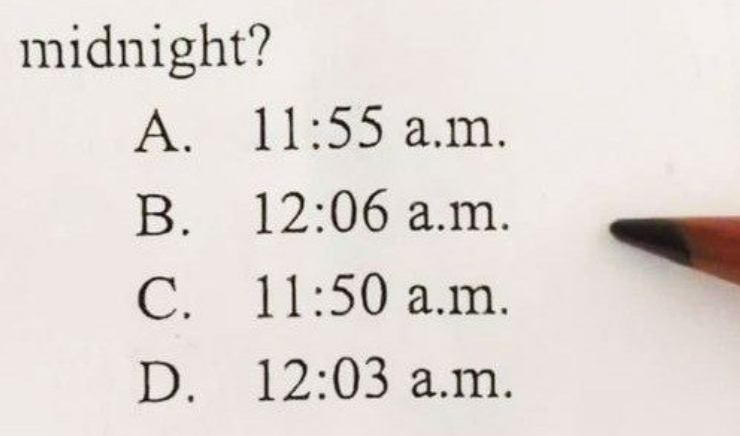Everyone enjoys a good brain teaser, and recently, a math puzzle has taken the internet by storm. Though it was initially designed for kids, it has captured the curiosity of people of all ages, sparking intense debates online. It all began on Reddit, where a seemingly straightforward question quickly transformed into a global conundrum.
Back in June 2023, a Reddit user from Jamaica, known as @yawdmontweet, posed a simple yet perplexing question:
“What is the closest time to midnight?”
The options given were:
A. 11:55 a.m.
B. 12:06 a.m.
C. 11:50 a.m.
D. 12:03 a.m.
What seemed like a clear-cut question soon spiraled into a viral discussion, garnering over 1.4 million views and countless comments. The key phrase, “closest time to,” left room for varied interpretations, turning this puzzle into a hot topic for debate.
The Popular Consensus: Option D (12:03 a.m.)
Most Reddit users leaned toward option D (12:03 a.m.) as the closest time to midnight. The reasoning was straightforward: 12:03 a.m. is just three minutes past midnight, making it the nearest time after the stroke of midnight.
However, not everyone agreed. Some argued that the wording of the question—specifically, the difference between “closest time to” versus “closest time until”—could change the answer entirely. For example, if interpreted as the closest time to the next midnight, then option A (11:55 a.m.) could be a valid answer, as it’s just minutes away from the approaching midnight in the evening.
Looking at It from Different Angles
The debate became even more interesting when people started analyzing the puzzle from creative perspectives. Some thought the term “midnight” itself could influence the answer. They argued that option A (11:55 a.m.) is closer to the next midnight on the same day, which might make it more aligned with the idea of “approaching midnight.”
Others pointed out that option B (12:06 a.m.), although slightly farther from midnight than 12:03 a.m., is still relatively close, making it another contender. Meanwhile, option C (11:50 a.m.) was mostly dismissed because it was considered too far from either midnight.
Artificial Intelligence Weighs In
Amid the online frenzy, some people turned to AI for a definitive answer. ChatGPT, a popular AI chatbot, confidently declared that D (12:03 a.m.) was the correct answer. This added fuel to the debate, with many agreeing that AI’s logic was sound, as it focused on the closest time immediately after midnight.
Weighing the Pros and Cons of Each Option
To break it down further, here’s a quick analysis of each choice:
Option A: 11:55 a.m.
Pros: Closest to the next midnight later that day.
Cons: Not the closest immediately after midnight.
Option B: 12:06 a.m.
Pros: Only six minutes past midnight, which is relatively close.
Cons: Slightly farther from midnight than 12:03 a.m.
Option C: 11:50 a.m.
Pros: Before noon, indicating it’s closer to the upcoming midnight.
Cons: Farther from midnight compared to the options immediately after.
Option D: 12:03 a.m.
Pros: Just three minutes past midnight, making it the closest time directly following midnight.
Cons: None, as it aligns well with the concept of the time immediately after midnight.
A Puzzle That Challenges Our Thinking
This math puzzle isn’t just about figuring out the closest time to midnight; it’s also a fascinating exploration of how our minds work. It challenges us to think critically, consider different perspectives, and engage in lively discussions. Whether you lean toward option D for its proximity just after midnight or find the arguments for option A more convincing, this puzzle highlights how interpretation can shift depending on one’s perspective.
Ultimately, the beauty of this puzzle lies in its ability to provoke thought and debate. It’s not just a test of math skills but also a reflection of how we approach problem-solving.
So, which option do you think is correct? Is it as simple as choosing the closest time after midnight, or is there more to it depending on how you interpret the question? Dive into the discussion, and see where your logic takes you in this viral brain teaser!

